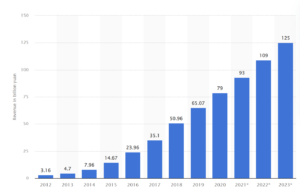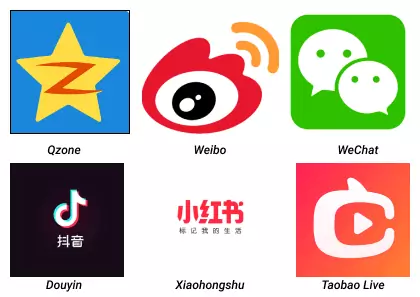China has a social media ecosystem that is quite different from the rest of the world. With Facebook, Twitter, YouTube, and other western social media platforms banned in the country, Chinese internet users have created their own unique influencer market. And it has become a very lucrative business in recent years.
China’s Influencer Market is the world’s largest social media market. The “great firewall of China” has greatly contributed to making this industry unique and powerful. The largest social media platforms in the country being WeChat, Qzone and Sina Weibo. The main players are called Key Opinion Leaders (or KOLs) and that is why you might also hear of it as KOL Marketing.
But, how strong is this industry really?
The influencer industry in China 2025
In China, there are 1.1 billion internet users as of 2025, compared to the 331 million internet users in the USA as of that same year (Statista). 1.1 billion chinese people are also social media users in 2025. Referring to these numbers, it is not a surprise that global brands are looking to build their presence on the main Chinese social media platforms.
Let’s take a closer look at the data:
In 2023, social media ad revenue in China reached $71.3 billion USD; for 2025, it is forecasted that the Chinese ad revenue will reach about $96.82 billion USD, a growth rate of roughly 10.59% per year (Statista).

Interestingly, the COVID-19 crisis has positively impacted the industry. With more people staying at home, scrolling on their phones, and doing online shopping, many brands have invested in e-commerce KOLs, internet celebrities, and Micro-KOLs to promote their products.
In 2023, the total market value of Influencer Marketing in China was $13.71 billion USD (Statista). In 2025, China is expected to continue dominating the influencer market, holding a bit over 65% of the share (Statista). This is an opportunity both for local and foreign companies that are searching for profitable ways to advertise in China.
How Chinese influencer Marketing works: Key Players
When shaping your own social media strategy in the country, it is important to fully understand the nuances of Chinese consumers, platforms, and content. Since this market can be hard to navigate for newcomers, let’s start breaking down some Key Points:
There are two kinds of Chinese influencers: KOL and KOC.
- KOL: Key Opinion Leaders. Photo and video bloggers, columnists, or reporters with strong abilities to influence consumers’ purchasing decisions. They may sound like regular western influencers, but their engagement is quite a bit higher. KOL fans are very loyal, and agree with them in almost all their values and carefully follow their recommendations.
- KOC: Key Opinion Consumer. It can be understood as a KOL with a smaller number of fans, or an amateur in a certain field. They are more closely connected with social media users, and influence other users through empathy.
KOL influencers are observed all over Asia, and are deemed particularly important in South Korea. Check out InterAd’s influencer marketing article for a more detailed explanation.
Keep up with all business-relevant APAC trends by reading our regularly updated articles – TikTok trends, 2025 e-commerce & 2025 consumer trends.
Another important point to clarify is the platforms. The sector is very fragmented and local, and marketers require significant expertise to navigate their way. Some of the sector’s main platforms are:

- Weibo: usually understood as a Chinese-based mini-blogging service, including social chat sites and platform sharing. Weibo blogs use a format similar to Twitter but are almost exclusively used by Chinese language speakers. The most popular microblogs are Sina Weibo and Tencent Weibo.
- WeChat: a multi-purpose app that combines social media, messaging, and mobile payment with over 1 billion monthly active users. It is also described as a “super app”, because of its wide range of functions.
- Douyin: the original Chinese version of TikTok. The 2 products are similar, but their features are not identical. Also, Tiktok and Douyin have no access to each other’s content. Business verified users can promote to a specific audience, which allows them to choose where they want their video to be seen, such as a specific physical location.
- RedNote (Xiaohongshu): a social media and e-commerce platform with over 209 million monthly active users in 2024. Due to the “TikTok ban” that took place in 2025, the platform has indicated a surge of users by more than 30%. As of February 2025, the MAU of RedNote are more than 300 million.
- Qzone (QQ): a social networking service that allows users to write blogs, send photos, listen to music, and watch videos.
- Taobao Live: a live streaming service created by Alibaba with the goal of allowing online retailers to market their products through social shopping. Some of the largest Livestream KOLs use this platform to drive an incredible amount of sales.
Most popular influencers in China
Here are some of the most famous influencers. We made this short list as a reference, but the truth is that influencer marketing in China is so wide that it would be impossible to cover them all.
Austin (Jiaqi) Li

Also known as the “Lipstick King”, he is China’s strongest seller of lipsticks online and broke a record selling 15,000 lipstick in 5 minutes. He is a major male influencer on the online shopping website Taobao. Currently, he has 27.9 million fans on Weibo and 378 million fans on Douyin.
Xinba

Another major influencer on Chinese platforms such as Taobao, Douyin and Kuaishou, Xinba is considered the “Sales King” on the Kuaishou Video App. In 2019, he generated more than US$1.9 billion in sales through live streaming services.
Cherie

She is one of the most famous eCommerce KOLs on Taobao, being an expert in the fashion field. By publishing fashion content she has accumulated 4.17 million followers on Weibo and 8.63 million followers on the Taobao Store.
Feng Timo

Originally named Feng Yanan, she is a Chinese singer and internet personality, considered one of the “Top 10 Influential Big Verified accounts” of Sina Weibo. She has over 10.02 million followers on Weibo and over 17.5 million followers in Douyu.





